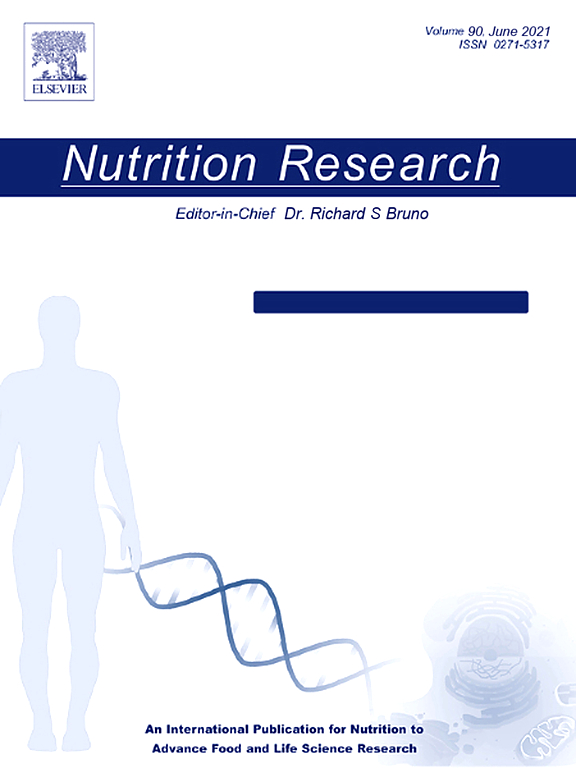在美国成年人中,适量摄入类胡萝卜素可以预防肌肉减少性肥胖:一项横断面研究
IF 3.1
3区 医学
Q2 NUTRITION & DIETETICS
引用次数: 0
摘要
类胡萝卜素因其强大的抗炎和抗氧化特性而被公认具有潜在的健康益处。然而,关于类胡萝卜素摄入和肌肉减少性肥胖(SO)之间具体关系的证据仍然有限。我们假设适量的类胡萝卜素摄入与较低的SO风险相关。研究人员对2011-2018年全国健康与营养调查中10060名18至59岁的成年人进行了横断面研究。通过双能x线吸收仪评估全身成分,而通过两次24小时饮食回忆访谈获得类胡萝卜素摄入量。本研究采用加权逻辑回归模型、分层分析、限制三次样条分析和敏感性分析。SO加权患病率为7.51%。加权logistic回归分析结果显示,考虑各种因素后,膳食α-胡萝卜素、β-胡萝卜素和β-隐黄质摄入量与SO风险呈负相关。年龄分层分析显示,在40至59岁的成年人中,α-胡萝卜素摄入量与SO风险呈显著负相关,而在18至39岁的年龄组中,β-胡萝卜素和β-隐黄质表现出类似的负相关关系。性别分层分析表明,女性α-胡萝卜素、β-胡萝卜素和β-隐黄质摄入量的最高分位数与SO的风险呈负相关。限制性三次样条回归分析显示,饮食中α-胡萝卜素、β-胡萝卜素和β-隐黄质的摄入量与SO风险呈u型相关,特别是在40-59岁的女性和女性中。综上所述,饲粮中α-胡萝卜素(0.77 mg/d)、β-胡萝卜素(3.93 mg/d)和β-隐黄质(0.19 mg/d)摄入量适中与较低的SO风险相关。这些类胡萝卜素与SO之间的关系是非线性的,特别是在40至59岁的个体和女性中。本文章由计算机程序翻译,如有差异,请以英文原文为准。

Moderate carotenoid intakes protect against sarcopenic obesity among U.S. adults: A cross-sectional study
Carotenoids have been recognized for their potential health benefits due to their potent anti-inflammatory and antioxidant properties. However, evidence regarding the specific relationship between carotenoid intake and sarcopenic obesity (SO) remains limited. We hypothesized that moderate carotenoid intake was associated with a lower SO risk. A cross-sectional study was conducted involving 10,060 adults aged 18 to 59 from the National Health and Nutrition Examination Survey 2011-2018. Whole-body composition was assessed by dual-energy X-ray absorptiometry, while carotenoid intake was obtained through two 24-hour dietary recall interviews. Weighted logistic regression models, stratified analyses, restricted cubic spline analyses, and sensitivity analyses were utilized for this study. The weighted prevalence of SO was 7.51%. Weighted logistic regression revealed that dietary α-carotene, β-carotene, and β-cryptoxanthin intake was inversely associated with SO risk after accounting for various variables. Age-stratified analyses revealed a significant inverse association between α-carotene intake and SO risk among adults aged 40 to 59, whereas β-carotene and β-cryptoxanthin exhibited similar inverse relationships in the 18 to 39 age group. The sex-stratified analysis demonstrated that the highest tertile of α-carotene, β-carotene, and β-cryptoxanthin intake was inversely correlated with the risk of SO among females. Restricted cubic spline regression analysis revealed a U-shaped association between dietary intake of α-carotene, β-carotene, and β-cryptoxanthin with SO risk, particularly in 40-59-year-olds and females. In conclusion, moderate dietary α-carotene (0.77 mg/day), β-carotene (3.93 mg/day), and β-cryptoxanthin (0.19 mg/day) consumption was associated with a lower SO risk. The relationship between these carotenoids and SO was nonlinear, particularly among individuals aged 40 to 59 years and in females.
求助全文
通过发布文献求助,成功后即可免费获取论文全文。
去求助
来源期刊

Nutrition Research
医学-营养学
CiteScore
7.60
自引率
2.20%
发文量
107
审稿时长
58 days
期刊介绍:
Nutrition Research publishes original research articles, communications, and reviews on basic and applied nutrition. The mission of Nutrition Research is to serve as the journal for global communication of nutrition and life sciences research on diet and health. The field of nutrition sciences includes, but is not limited to, the study of nutrients during growth, reproduction, aging, health, and disease.
Articles covering basic and applied research on all aspects of nutrition sciences are encouraged, including: nutritional biochemistry and metabolism; metabolomics, nutrient gene interactions; nutrient requirements for health; nutrition and disease; digestion and absorption; nutritional anthropology; epidemiology; the influence of socioeconomic and cultural factors on nutrition of the individual and the community; the impact of nutrient intake on disease response and behavior; the consequences of nutritional deficiency on growth and development, endocrine and nervous systems, and immunity; nutrition and gut microbiota; food intolerance and allergy; nutrient drug interactions; nutrition and aging; nutrition and cancer; obesity; diabetes; and intervention programs.
 求助内容:
求助内容: 应助结果提醒方式:
应助结果提醒方式:


